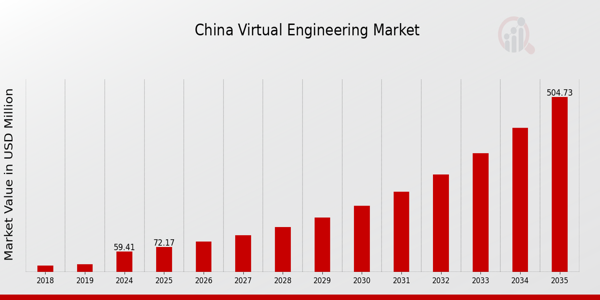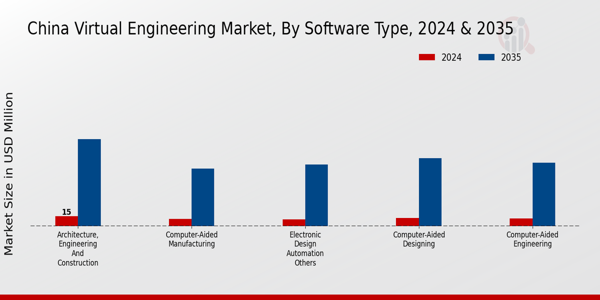China Virtual Engineering Market Overview
As per MRFR analysis, the China Virtual Engineering Market Size was estimated at 51.33 (USD Million) in 2023.The China Virtual Engineering Market Industry is expected to grow from 59.41(USD Million) in 2024 to 504.78 (USD Million) by 2035. The China Virtual Engineering Market CAGR (growth rate) is expected to be around 21.471% during the forecast period (2025 - 2035)
Key China Virtual Engineering Market Trends Highlighted
Significant trends are being observed in the China Virtual Engineering Market as a result of the country's accelerated adoption of digital technologies and a strong push from government initiatives toward advanced manufacturing. The growing demand for virtual engineering solutions that improve efficiency and shorten the product lifecycle are among the primary market drivers. The incorporation of virtual engineering across a variety of sectors, including automotive, aerospace, and construction, is being driven by the active promotion of Industry 4.0 and digital transformation by the Chinese government.
This emphasis on modernization creates an environment in which industries can utilize virtual engineering to enhance their design processes and collaboration. The field offers a plethora of opportunities for exploration, particularly in sectors such as infrastructure and urban development, where virtual simulation can simplify project management and reduce costs. Furthermore, the increasing number of academic and research institutions that are integrating virtual engineering curricula is indicative of the expanding talent pool, which in turn stimulates innovation. The utilization of technologies such as artificial intelligence (AI) and augmented reality (AR) in virtual engineering practices has been on the rise in recent years, enabling the development of more realistic simulations and improved user experiences.
Additionally, there is a growing trend of partnerships between technology companies and traditional engineering companies, which offers a platform for enhanced project execution and knowledge sharing. The incorporation of sustainable practices into virtual engineering is also a noteworthy trend, which is consistent with China's objectives of achieving carbon neutrality and environmental conservation by 2060. This change promotes the utilization of virtual tools to simulate and assess the environmental impact of projects and the development of eco-friendly engineering solutions. The China Virtual Engineering Market is characterized by a confluence of technology enhancement, policy support, and an increasing emphasis on sustainability, which is paving the way for continuous growth and innovation. In general, the landscape is dynamic.

Source: Primary Research, Secondary Research, MRFR Database and Analyst Review
China Virtual Engineering Market Drivers
Growing Investment in Smart Manufacturing
In recent years, China has significantly emphasized the development of smart manufacturing as part of its economic strategy, particularly highlighted in the Made in China 2025 initiative. According to the Ministry of Industry and Information Technology of the People's Republic of China, the smart manufacturing sector is projected to grow at a staggering rate, driven by government support and investment incentives, with funding expected to reach approximately 1 trillion Chinese Yuan by 2025.
This substantial financial backing will accelerate the adoption of technologies such as virtual engineering, which allows for simulation, modeling, and optimization in manufacturing processes. Companies like Huawei, through their extensive Research and Development initiatives, are actively contributing to the advancement of Virtual Engineering capabilities, enhancing the overall competitiveness and efficiency of manufacturing in China. The increasing focus on efficient and cost-effective production will significantly drive the growth of the China Virtual Engineering Market Industry.
Rising Demand for Sustainable Engineering Solutions
The demand for sustainable solutions in engineering is surging in China, where the government has set ambitious targets to reduce carbon emissions and transition towards renewable energy sources. The National Development and Reform Commission has indicated that environmental technology and green engineering will constitute a key focus area for investment, with expected annual growth rates of 15-20% over the next decade.
This trend is exacerbated by international agreements, pushing companies towards eco-friendly practices.Enterprises such as Sinopec are increasingly adopting virtual engineering techniques to minimize waste and optimize resource usage, leading to a lower environmental footprint. This paradigm shift towards sustainability is expected to propel the growth of the China Virtual Engineering Market Industry, as companies leverage virtual engineering solutions to comply with governmental regulations and meet consumer expectations for greener practices.
Technological Advancements in Virtual Engineering Tools
The rapid evolution of virtual engineering tools and technologies is acting as a significant growth driver in the China Virtual Engineering Market Industry. With an increasing number of software vendors, including Autodesk and Siemens, entering the Chinese market, there are innovative solutions becoming available that enhance design and simulation capabilities.
For instance, advancements in artificial intelligence and machine learning, integrated into virtual engineering tools, allow for predictive analytics and smart modeling, significantly enhancing design efficiency.Reports indicate that the adoption of advanced simulation software can improve project delivery times by as much as 30%, contributing to overall cost savings. The acceleration of technology adoption among Chinese businesses is creating a robust environment for virtual engineering applications, thereby fostering market growth.
China Virtual Engineering Market Segment Insights
Virtual Engineering Market Software Type Insights
The China Virtual Engineering Market has shown significant growth in recent years, particularly within the Software Type segment, which plays a crucial role in driving innovation across various industries. In this growing arena, the Computer-Aided Designing (CAD) software has emerged as a cornerstone, enabling designers and engineers to create detailed digital blueprints, thereby streamlining the design process and fostering collaboration among teams. This has resulted in enhanced productivity and reduced time-to-market for products, making CAD software essential for industries ranging from manufacturing to consumer goods.
Computer-Aided Manufacturing (CAM) plays an equally important role by optimizing the processes that follow design, allowing for precise control over machinery and production workflows. This not only improves production efficiency but also minimizes waste by ensuring that manufacturing is as accurate as possible. Furthermore, Computer-Aided Engineering (CAE) is pivotal in allowing engineers to conduct simulations and analyses of designs under various conditions, leading to refinement and optimization before physical products are produced. This aspect significantly contributes to risk management and resource allocation, ensuring that projects remain within budget and timelines.
In the realm of Architecture, Engineering, and Construction (AEC), software solutions have vastly improved project planning and execution by fostering better communication among various stakeholders. The adoption of advanced software tools aids in modeling complex structures, assessing environmental impacts, and enhancing sustainability initiatives. This is particularly relevant in China, where the government has been advocating for green construction methods to address environmental concerns and promote sustainable urbanization. Additionally, Electronic Design Automation (EDA) software is gaining traction in the electronics sector, empowering engineers to design, analyze, and optimize electronic systems efficiently. As China continues to advance in technology and innovation, these software tools are indispensable in facilitating complex design processes, boosting the country's competitiveness on the global stage.
With the China Virtual Engineering Market actively evolving, opportunities abound as industries increasingly integrate these software solutions to enhance their operational effectiveness and drive growth. The software type segment not only underscores the technological prowess of the nation but also presents various challenges such as the need for continuous training and adaptation to rapidly changing technologies. Addressing these challenges will be key to harnessing the full potential of the software tools driving the China Virtual Engineering Market. Overall, this segment stands as a beacon of progress and innovation, significantly impacting multiple industries and shaping the future of engineering practices within the country.

Source: Primary Research, Secondary Research, MRFR Database and Analyst Review
Virtual Engineering Market Deployment Type Insights
The China Virtual Engineering Market is experiencing robust growth, particularly in its Deployment Type segment, which consists of On-premises and Cloud solutions. The On-premises deployment remains a reliable choice for enterprises that prioritize control over their data and systems, offering enhanced security and customization tailored to specific needs. On the other hand, Cloud deployment is gaining significant traction due to its flexibility and cost-effectiveness, allowing businesses to scale operations without heavy investment in infrastructure.
The increasing adoption of digital technologies in China, coupled with supportive government policies promoting innovation in technology, is driving the demand for both deployment types. Additionally, the growing emphasis on remote collaboration and digital ecosystems created by emerging technologies like Artificial Intelligence and the Internet of Things is further propelling the shift towards Cloud. This dynamic environment presents ample opportunities for stakeholders in the China Virtual Engineering Market, as they look to leverage these deployment types to enhance service delivery and improve operational efficiency.The diversification in deployment preferences highlights the market's evolution and the necessity for companies to adapt to meet varying customer requirements.
Virtual Engineering Market Organization Size Insights
The Organization Size segment of the China Virtual Engineering Market reflects a dynamic landscape characterized by a diverse mix of Small and Medium Enterprises (SMEs) and Large Enterprises. SMEs play a crucial role in driving innovation and adopting virtual engineering solutions, reflecting agility in integrating new technologies. The growth of SMEs is fueled by the increasing demand for cost-effective solutions and the need to enhance operational efficiencies within China's bustling economy. Conversely, Large Enterprises dominate the market with significant investments in advanced virtual engineering technologies, leveraging their resources for Research and Development to stay competitive in the global market.
This segment experiences strong demand due to the rising complexity of engineering projects and a growing need for collaborative design processes that enhance productivity. The rapid digitalization and government initiatives aimed at supporting technological advancement also contribute to the flourishing of both SMEs and Large Enterprises. Overall, the segmentation within Organization Size, emphasizing the balance between innovation-driven SMEs and established large-scale operations, offers valuable insights into the ongoing evolution of the virtual engineering landscape in China.
Virtual Engineering Market Application Insights
The Application segment of the China Virtual Engineering Market has demonstrated significant growth potential, driven by the increasing adoption of digital technologies across various industries. Automation Design plays a critical role in streamlining processes and enhancing efficiency, making it a key focus area for manufacturers seeking to optimize production. Plant Design facilitates better facility layouts and resource management, contributing to improved operational performance in sectors such as energy, chemicals, and manufacturing.
Additionally, Product Design is becoming increasingly vital, enabling companies to innovate and reduce time-to-market through rapid prototyping and simulation techniques.3D Modeling technology enhances visualization and design accuracy, ensuring that projects meet quality standards and client specifications, which is particularly important in construction and engineering projects in China. Meanwhile, other applications within this segment encompass a diverse range of tools and technologies, allowing for tailored solutions that cater to unique operational challenges. Overall, the China Virtual Engineering Market segmentation showcases a robust framework for industry players to explore emerging opportunities and leverage digital advancements to drive growth and efficiency across multiple sectors.
Virtual Engineering Market Industry Vertical Insights
The Industry Vertical segment of the China Virtual Engineering Market plays a pivotal role in shaping the overall landscape of the industry. The Commercial Industry Vertical is significant as it addresses the growing demand for efficient project management, cost-effective solutions, and innovative design processes in various sectors such as manufacturing, construction, and consumer electronics. In China, where business operations are rapidly evolving, virtual engineering techniques are increasingly adopted to enhance product development cycles and streamline operational workflows.
On the other hand, the Defense Industry Vertical stands out due to its focus on advanced simulations and modeling, which are crucial for military applications and national security initiatives. Given China's emphasis on strengthening its defense capabilities, virtual engineering has gained traction in areas such as weapon system design, military training, and logistics optimization, thus becoming a fundamental aspect of defense strategy. Overall, the segmentation within the China Virtual Engineering Market reflects the diversity and specialized needs of different industries, each leveraging virtual engineering to drive innovation and efficiency in their operations.
China Virtual Engineering Market Key Players and Competitive Insights
The competitive insights of the China Virtual Engineering Market reveal a landscape characterized by rapid technological advancements, increasing adoption of digital solutions, and a strong push towards improving engineering efficiency through innovative technologies. The market is witnessing a surge in demand for virtual engineering solutions that enable businesses to optimize their engineering processes and enhance collaboration among teams. Companies operating in this space are leveraging modern tools and workflows to facilitate virtual prototyping, simulation, and model-based engineering.
The competition is shaped by a selection of global and regional players who are actively participating in reshaping the virtual engineering offerings to meet diverse industry needs in China.PTC has established a notable presence in the China Virtual Engineering Market, showcasing distinctive strengths in its offerings. The company’s commitment to enhancing product development through its advanced software solutions has enabled it to cater to various sectors, including manufacturing and telecommunications. Its pioneering capabilities in product lifecycle management and IoT integration have been instrumental in driving its growth within the region. PTC’s focus on delivering insightful analytics and facilitating collaboration among engineering teams further strengthens its market position in China.
This competitive edge is supported by its continuous investment in technology and strategic partnerships aimed at expanding its footprint in the dynamic virtual engineering landscape.Hexagon is also a key player in the China Virtual Engineering Market, where it offers a wide array of products and services, specifically in measurement and visualization technologies. With strengths in smart manufacturing solutions and advanced data analytics, Hexagon is well-positioned to provide high-quality engineering tools that assist organizations in optimizing processes and improving productivity. The company has built a robust market presence through strategic acquisitions which have expanded its range of solutions tailored for local industries. Its commitment to continuous innovation is reflected in its investment in research and development, allowing it to deliver cutting-edge technologies that address the unique challenges faced by the Chinese market. With an established support network and an emphasis on customer-centric solutions, Hexagon aims to leverage its strengths to capitalize on the growing demand for virtual engineering tools in China.
Key Companies in the China Virtual Engineering Market Include
- PTC
- Hexagon
- Ansys
- Siemens
- Bentley Systems
- Autodesk
- Beijing Sanjing Sanpin
- China State Construction Engineering
- China National Petroleum Corporation
- Altair Engineering
- Dassault Systemes
- ZWSOFT
- ANSYS
China Virtual Engineering Market Industry Developments
Recent developments in the China Virtual Engineering Market have been significant, particularly with the growth and investment from major companies like PTC, Siemens, and Autodesk. As of September 2023, China's government is emphasizing the digital transformation of industries, leading to increased demand for virtual engineering solutions. Notably, in July 2023, Hexagon announced plans to expand its digital solutions in China, aiming to enhance smart manufacturing capabilities. Current affairs highlight collaborations between academia and industry, such as Shanghai Jiao Tong University partnering with Dassault Systemes to advance Research and Development in virtual engineering technologies.
Recent mergers and acquisitions also shape the market; for instance, in August 2023, Altair Engineering completed a strategic acquisition of a Chinese cloud computing firm, further solidifying its presence in the region. In the past couple of years, the market valuation of companies such as China State Construction Engineering and China National Petroleum Corporation has shown substantial growth, reflecting a strong commitment to integrating virtual engineering into project management and operational efficiency. Overall, the focus on innovation and digitalization is propelling the China Virtual Engineering Market toward a more competitive landscape.
China Virtual Engineering Market Segmentation Insights
Virtual Engineering Market Software Type Outlook
-
- Computer-Aided Designing (CAD)
- Computer-Aided Manufacturing (CAM)
- Computer-Aided Engineering (CAE)
- Architecture, Engineering and Construction (AEC)
- Electronic Design Automation (EDA)Others
Virtual Engineering Market Deployment Type Outlook
Virtual Engineering Market Organization Size Outlook
Virtual Engineering Market Application Outlook
-
- Automation Design
- Plant Design
- Product Design
- 3D MODELLING
- Others
Virtual Engineering Market Industry Vertical Outlook
-
- Commercial Industry Vertical
- Defense Industry Vertical
| Report Attribute/Metric Source: |
Details |
| MARKET SIZE 2023 |
51.33(USD Million) |
| MARKET SIZE 2024 |
59.41(USD Million) |
| MARKET SIZE 2035 |
504.78(USD Million) |
| COMPOUND ANNUAL GROWTH RATE (CAGR) |
21.471% (2025 - 2035) |
| REPORT COVERAGE |
Revenue Forecast, Competitive Landscape, Growth Factors, and Trends |
| BASE YEAR |
2024 |
| MARKET FORECAST PERIOD |
2025 - 2035 |
| HISTORICAL DATA |
2019 - 2024 |
| MARKET FORECAST UNITS |
USD Million |
| KEY COMPANIES PROFILED |
PTC, Hexagon, Ansys, Siemens, Bentley Systems, Autodesk, Beijing Sanjing Sanpin, China State Construction Engineering, China National Petroleum Corporation, EPLAN, Altair Engineering, Shanghai Jiao Tong University, Dassault Systemes, ZWSOFT, ANSYS |
| SEGMENTS COVERED |
Software Type, Deployment Type, Organization Size, Application, Industry Vertical |
| KEY MARKET OPPORTUNITIES |
Increased demand for smart manufacturing, Expansion of AI-driven simulations, Growth in remote collaboration tools, Rise of digital twin technology, Investment in sustainable engineering solutions |
| KEY MARKET DYNAMICS |
increased demand for digital twins, rising investments in R&D, growth in infrastructure projects, adoption of cloud computing solutions, enhancement of design collaboration tools |
| COUNTRIES COVERED |
China |
Frequently Asked Questions (FAQ):
The China Virtual Engineering Market is valued at approximately 59.41 million USD in 2024.
The market is expected to grow to around 504.78 million USD by the year 2035.
The CAGR for the market during the forecast period is anticipated to be 21.471 percent.
Key software types include Computer-Aided Designing, Computer-Aided Manufacturing, Computer-Aided Engineering, Architecture, Engineering and Construction, and Electronic Design Automation.
Major players include PTC, Hexagon, Ansys, Siemens, Bentley Systems, Autodesk, and several others.
The market for Computer-Aided Designing is projected to reach approximately 101.5 million USD by 2035.
The Computer-Aided Manufacturing segment is forecasted to achieve a value of around 86.0 million USD by 2035.
This segment is expected to grow to about 130.0 million USD by 2035.
Growth drivers include advancements in technology, increasing demand for software in design processes, and rising investments in engineering solutions.
Regional development is significantly driving market growth, particularly in urbanization and infrastructure projects across China.
















